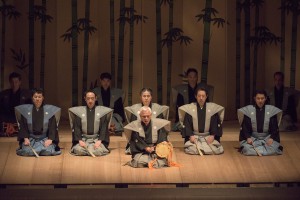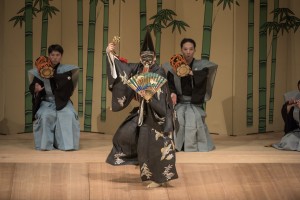JQ Magazine: Carnegie Hall Hosts ‘Grand Japan Theater’

The noh portion of the evening featured Living National Treasure Kamei Tadao: “For those who attended, this was a once-in-a-lifetime experience, which fulfilled the promise of Japanese performing arts that made many of us fall in love with the culture in the first place.” (Masahito Ono)
By Vlad Baranenko (Saitama-ken, 2000-02) for JQ magazine. Vlad is an avid photographer.
On March 1, Carnegie Hall’s Stern Auditorium hosted Grand Japan Theater (also billed as An Evening of Japanese Traditional Theatre), which presented New York City with a spectacular rare performance of kyogen, noh and kabuki—all in one night. After kicking off their international tour in Tokyo and Osaka, then traveling halfway across the globe to introduce the first ever kabuki/noh performance to the royal family of Fujairah in the United Arab Emirates, the troupe finally arrived in the U.S. for one special night.
A sold-out crowd of over 2,800 witnessed some of the biggest names in traditional Japanese theater, including the noh otsuzumi artist Kamei Tadao, who in 2002 was designated as a Living National Treasure; the internationally renowned kabuki and television actor Ichikawa Ebizo XI, who began his career at just six years old and has evolved into one of the most versatile traditional actors today; and many more with direct roots to these beautiful centuries-old art forms.
The backdrop for all of the evening’s performances featured three sets of traditional Japanese screens adorned with illustrations of bamboo that blended perfectly into the background despite the enormity of the hall. The night’s program began with the kyogen piece Sanbaso. (Kyogen, an art form that almost always accompanies a noh performance and acts as a short, often comical “intermission piece” for the audience, has traditionally been based on a Shinto religious rite that prays for peace, fertility and prosperity across the land.)
At the onset of the performance, a lone man walked upon a dimly lit stage that invoked a paper lantern-lit street. The pace of the steps in tune with the drum beat set the tone of the evening, and despite the massive audience, an inviting silence welcomed the performers. The drummers (which included Living National Treasure Kamei), flute player and a mask box bearer were positioned in the back, with the shite (lead) performer (Shigeyama Ippei) clutching a paper fan during his rhythmic dance with an accompanying chant as prayer to the gods. The ornate turquoise and gold costumes of the musicians and the beautifully embroidered kimonos of the dancers perfectly aligned with the beat on the specially designed stage, which created a unique sound that reverberated throughout the theater.
For the second half of the dance (from which the Sanbaso is named), the shite dons the mask of an Okina, a character tinged with divine qualities, and prayers were sung for a bountiful harvest through a requiem by “hardening” the ground with driving stomps, while the ringing of suzu bells symbolized ears of rice. Though traditionally played by the assistant (kyōgenkata), Sanbaso performances generally differ from regular kyogen as a specific Shinto ritual performed after the actors have gone through a purifying fasting and abstention.
At the conclusion of the kyogen ceremony, the musicians and the shite silently walked off the stage while a seven piece musician chorus group assembled on the sides to begin the noh portion of the night. Labeled as one of the world’s oldest theatrical art forms, noh plays have traditionally been reserved for nobility, and the modern version of noh encompasses 200 different masks to portray a variety of characters. This performance titled Tsuchigumo, or The Earth Spider, follows a sick and bedridden hero who narrowly escapes death when visited by a spider spirit (Katayama Kurouemon) dressed as a monk, and is avenged by his servant Hitorimusha (Hosho Kinya) using the hero’s legendary sword in a heated man-against-demon battle at the spider’s lair that eventually sees the defeat of the monster.
Tsuchigumo was historically used as a derogatory term for rebel local clans, and is also the name for a race of spider-like ghouls in Japanese folklore. The elaborate costumes of the hero, the gold-black robes and the eerie red-haired wig of the spider and the dramatic music and chorus for every “act” in this play left the audience with deep appreciation for this sensational performance art. From the symbolism used for the monstrous spider’s lair as a webbed cage to the sword slashing through the spider’s attacks, one of the most impressive moments and a notable highlight of this play was the flying paper streamers launched by the spider. It is said that the current version of play was created in the early Meiji period, and adds a spectacular visual style to the performance.
The third and the final portion of the night was the kabuki Shunkyo Kagamijishi. First performed in 1893, the story follows Yayoi (Ichikawa Ebizo XI), a lady-in-waiting who is chosen to perform a New Year’s lion dance for the shogun. Initially shy, the young maiden is overcome with the spirit of the lion and eventually becomes the lion himself (in a dual role by Ichikawa). Distracted by two dancing butterflies, the lion in turn retreats to his den where the butterfly-lion dance continues to the amusement of the viewer.

Ichikawa Ebizo XI, center, with Ichikawa Fukunosuke and Ichikawa Fukutaro in Shunkyo Kagamijishi. (Masahito Ono)
Originally performed by female actors, the early Edo period forbade women to take part in kabuki, giving birth to the yaro (men’s) kabuki version that we see today. The apex of the performance was the visual “transformation” of the maiden into the lion, with the choreography and the full “orchestra” paired with quintessential Kabuki visuals, underscoring its enduring appeal.
The notably sensual and feminine dance movements of Yayoi in the beginning radiated with shyness and youth, which later became almost violent with the dramatic hair-spinning sequence of the lion, truly displaying the demanding versatility of the performer. Likewise, the butterflies played by the young Ichikawa Fukutaro and Ichikawa Fukunosuke (ages 14 and 10, also from the family) flawlessly embodied the spirit of the fragile insect, gracing the stage with their perfectly synchronized movements to the delight of the audience.
For those who attended, this was a once-in-a-lifetime experience, which fulfilled the promise of Japanese performing arts that made many of us fall in love with the culture in the first place.
For more on Grand Japan Theater, visit www.ichikawaebizo.com/ny2016.




Comments are closed.